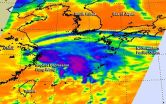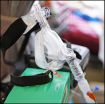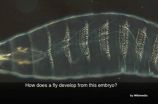(Press-News.org) Tropical Depression Fung-Wong skirted the coast of mainland China and is moving through the East China Sea. NASA's Aqua satellite captured cloud top temperature data that showed strongest thunderstorms were stretched out as the storm continues to look more frontal in nature.
When NASA's Aqua satellite passed over Fung-Wong on Sept. 22 at 1:23 p.m. EDT, the Atmospheric Infrared Sounder or AIRS instrument read cloud top temperatures. AIRS detected strongest, highest storms, those with the coldest cloud tops stretched out from northwest to southeast giving the depression an appearance more like a cold front than a depression.
On Sept. 23 at 1500 UTC (11 a.m. EDT) Tropical Depression Fung-Wong had maximum sustained winds near 30 knots 34.5 mph/55.5 kph). It was centered near 32.8 north latitude and 123.5 longitude, about 351 nautical miles west of Sasebo, Japan. It was moving to the northeast at 11 knots (12.6 mph/20.3 kph).
On Sept. 23, the Joint Typhoon Warning Center noted that there is a defined center of circulation near the southern edge of the large area of frontal clouds. There was also very limited thunderstorm development pushed over the northeastern quadrant by wind shear. That wind shear is pretty strong, blowing at up to 30 knots (34.5 mph/55.5 kph).
Fung-Wong isn't long for the world as it is also interacting with a frontal system located over the West Sea and South Korea. The storm has already started converting to an extra-tropical storm (the core of the storm is going from warm to cold).
Fung-Wong is expected to turn east-northeast toward southern Korea and gain frontal characteristics.
INFORMATION:
Rob Gutro
NASA's Goddard Space Flight Center
NASA sees Tropical Depression Fung-Wong becoming more frontal
2014-09-23
ELSE PRESS RELEASES FROM THIS DATE:
New research suggests sleep apnea screening before surgery
2014-09-23
Scheduled for surgery? New research suggests that you may want to get screened and treated for obstructive sleep apnea (OSA) before going under the knife. According to a first-of-its-kind study in the October issue of Anesthesiology, the official medical journal of the American Society of Anesthesiologists® (ASA®), patients with OSA who are diagnosed and treated for the condition prior to surgery are less likely to develop serious cardiovascular complications such as cardiac arrest or shock.
"OSA is a common disorder that affects millions and is associated with an increased ...
Recreating the stripe patterns found in animals by engineering synthetic gene networks
2014-09-23
VIDEO:
Researchers at the CRG try to understand how networks of genes work together to create specific patterns like stripes.
They have gone beyond studying individual networks and have created computational and...
Click here for more information.
Pattern formation is essential in the development of animals and plants. The central problem in pattern formation is how can genetic information be translated in a reliable manner to give specific spatial patterns of cellular differentiation. ...
Airway muscle-on-a-chip mimics asthma
2014-09-23
The majority of drugs used to treat asthma today are the same ones that were used 50 years ago. New drugs are urgently needed to treat this chronic respiratory disease, which causes nearly 25 million people in the United States alone to wheeze, cough, and find it difficult at best to take a deep breath.
But finding new treatments is tough: asthma is a patient-specific disease, so what works for one person doesn't necessarily work for another, and the animal models traditionally used to test new drug candidates often fail to mimic human responses – costing tremendous ...
Eating five a day may keep the blues away
2014-09-23
Fruit and vegetable consumption could be as good for your mental as your physical health, new research suggests.
The research, conducted by the University of Warwick's Medical School using data from the Health Survey for England, and published by BMJ Open focused on mental wellbeing and found that high and low mental wellbeing were consistently associated with an individual's fruit and vegetable consumption.
33.5% of respondents with high mental wellbeing ate five or more portions of fruit and vegetables a day, compared with only 6.8% who ate less than one portion. ...
Southampton scientists grow a new challenger to graphene
2014-09-23
A team of researchers from the University of Southampton's Optoelectronics Research Centre (ORC) has developed a new way to fabricate a potential challenger to graphene.
Graphene, a single layer of carbon atoms in a honeycomb lattice, is increasingly being used in new electronic and mechanical applications, such as transistors, switches and light sources, thanks to the unprecedented properties it offers: very low electrical resistance, high thermal conductivity and mechanically stretchable yet harder than diamond.
Now, ORC researchers have developed molybdenum di-sulphide ...
Search for better biofuels microbes leads to the human gut
2014-09-23
CHAMPAIGN, Ill. — Scientists have scoured cow rumens and termite guts for microbes that can efficiently break down plant cell walls for the production of next-generation biofuels, but some of the best microbial candidates actually may reside in the human lower intestine, researchers report.
Their study, reported in the Proceedings of the National Academy of Sciences, is the first to use biochemical approaches to confirm the hypothesis that microbes in the human gut can digest fiber, breaking it down into simple sugars in order to ferment them into nutrients that nourish ...
Results of the 1st EORTC Cancer Survivorship Summit
2014-09-23
A special issue of the European Journal of Cancer presents detailed reports on the wide range of research presented during the 1st EORTC Cancer Survivorship Summit held this past January in Brussels, Belgium.
Early diagnosis, targeted therapeutics, and more personalized multimodal treatments has boosted survival rates of patients with cancer and led to a large and rapidly increasing number of cancer survivors. Despite this good news, cancer survivors are often confronted with a broad spectrum of late adverse treatment effects and some must also deal with societal discrimination ...
Nanotubes help healing hearts keep the beat
2014-09-23
Carbon nanotubes serve as bridges that allow electrical signals to pass unhindered through new pediatric heart-defect patches invented at Rice University and Texas Children's Hospital.
A team led by bioengineer Jeffrey Jacot and chemical engineer and chemist Matteo Pasquali created the patches infused with conductive single-walled carbon nanotubes. The patches are made of a sponge-like bioscaffold that contains microscopic pores and mimics the body's extracellular matrix.
The nanotubes overcome a limitation of current patches in which pore walls hinder the transfer ...
Study uncovers genetic driver of inflammation, uses it to prevent and treat liver cancer
2014-09-23
Inflammation has been shown to be a driving force behind many chronic diseases, especially liver cancer, which often develops due to chronic inflammation caused by conditions such as viral hepatitis or alcoholism and has relatively few effective treatment options. Now, scientists at Virginia Commonwealth University Massey Cancer Center have demonstrated for the first time in preclinical studies that blocking the expression of a gene known as astrocyte elevated gene-1 (AEG-1) halts the development and progression of liver cancer by regulating inflammation. This research ...
Mother-infant bed sharing messaging should be tailored, according to UGA researcher
2014-09-23
Athens, Ga. – Bed sharing, a practice where mother and infant sleep on the same surface, remains popular all over the world despite potential health risks for the infant. According to a new University of Georgia study, bed sharing can likely be decreased if public health officials tailor messaging to their unique population.
Trina Salm Ward, assistant professor in the UGA School of Social Work and assistant professor of health promotion and behavior in the College of Public Health, reviewed literature on bed sharing in "Reasons for Mother-Infant Bed-Sharing: A Systematic ...






